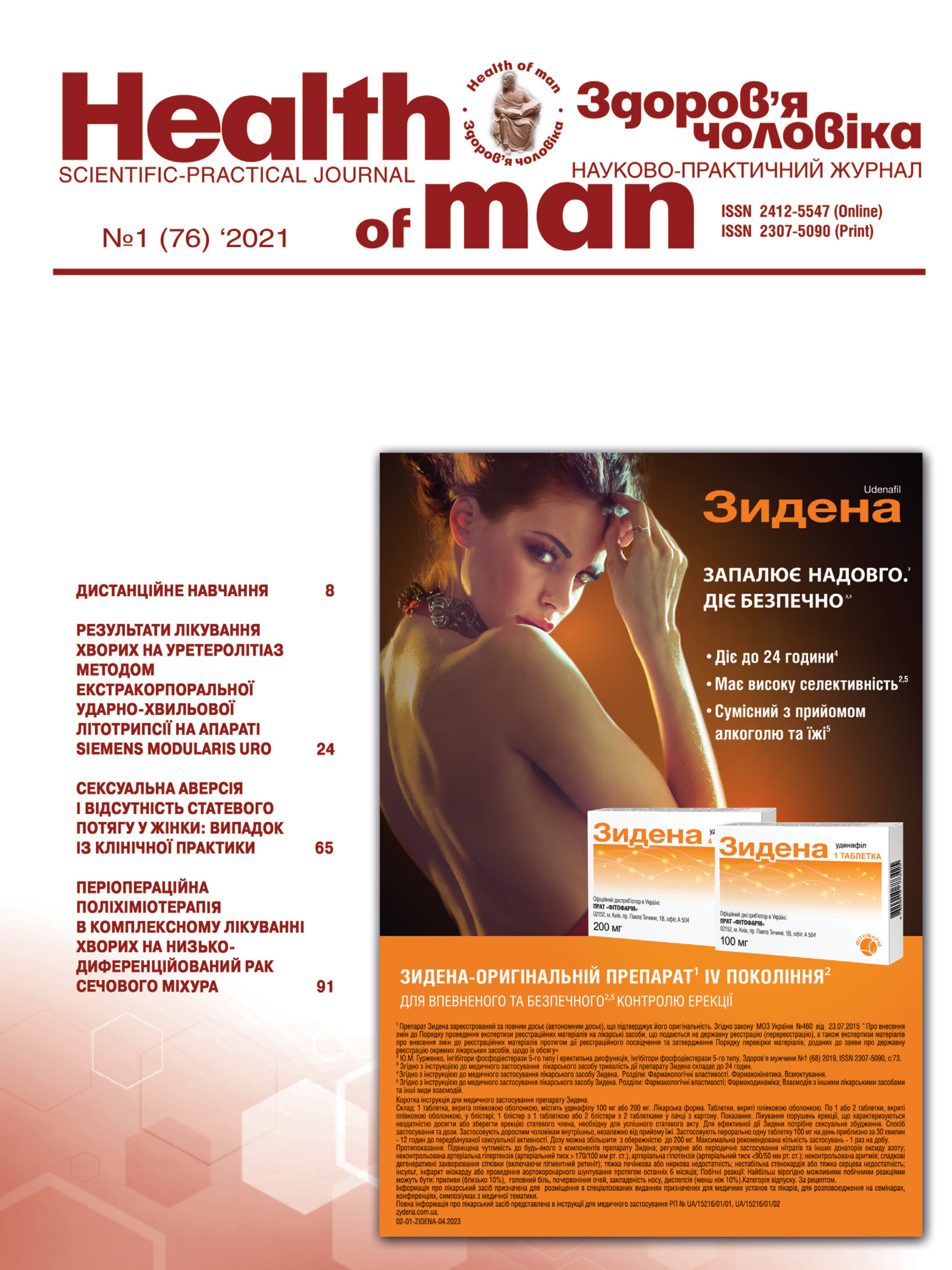Dutasteride 5α-reductase Inhibitor in the Treatment of Benign Prostatic Hyperplasia: Systematic Review and Meta-analysis
##plugins.themes.bootstrap3.article.main##
Abstract
Dutasteride is a competitive inhibitor of the enzyme 5-alpha-reductase and is commonly used to treat the symptoms of benign prostatic hyperplasia (BPH).
Objective: to determine the efficacy and safety of dutasteride in terms of indicators that are important in clinical practice.
Data sources. The literature was searched using the search terms «prostate hyperplasia», «prostate hypertrophy», «dutasteride», «quality of life», and «adverse drug reaction». Articles were obtained from Embase, PubMed, the Kokhranov Central Register of Controlled Trials, with a search till December 2020.
Study selection and data recovery. Randomized controlled trials, quasi-randomized trials, and systematic reviews evaluating the efficacy of dutasteride, both in monotherapy and in combination with alpha-blockers for the treatment of men with BPH were included in the analysis. Indicators were the need for prostate surgery, episodes of acute urinary retention, discontinuation of therapy due to side effects, the number of patients who had serious side effects, mortality and sexual dysfunction.
Data analysis. Four studies involving 1,879 patients were evaluated. All studies have shown significant clinical efficacy of dutasteride to the need for prostate surgery, with episodes of acute urinary retention that was higher than finasteride with equal safety profiles.
Conclusion. No statistically significant differences between the two 5AR inhibitors finasteride and dutasteride in terms of safety profile were found, based on the studies included in this system review. This determines the best clinical efficacy of dutasteride in terms of the number of cases of acute urinary retention and the need for surgery.
##plugins.themes.bootstrap3.article.details##

This work is licensed under a Creative Commons Attribution 4.0 International License.
Authors retain the copyright and grant the journal the first publication of original scientific articles under the Creative Commons Attribution 4.0 International License, which allows others to distribute work with acknowledgment of authorship and first publication in this journal.
References
Roehrborn C, McConnell J. Etiology, pathophysiology, epidemiology and natural history of benign prostatic hyperplasia. In:Walsh P, Retik A,Vaughan Jr E, Wein AJ, editors. Campbell’s urology. 8th ed. Philadelphia (PA): W B Saunders; 2002. pp. 1297–330.
Naslund M, Regan TS, Ong C, Hogue SL. 5-Alpha reductase inhibitors in men with an enlarged prostate: an evaluation of outcomes and therapeutic alternatives. Am J Manag Care. 2008;14(5 Suppl 2):S148–53.
Carson C, Rittmaster R.Therole of dihydrotestosteronein benign prostatic hyperplasia. Urology. 2003;61(4 Suppl 1):2–7.
Nickel JC. Comparison of clinical trials with finasteride and dutasteride. Rev Urol. 2004;6 Suppl 9:S31–9.
Clark RV, Hermann DJ,Cunningham GR,WilsonTH, Morrill BB, Hobbs S. Marked suppression of dihydrotestosterone in men with benign prostatic hyperplasia by dutasteride, a dual 5alphareductase inhibitor. J Clin Endocrinol Metab. 2004;89(5):2179–84.
ConteT,TruzziJC,Tannus G, Fonseca M. Systematic review comparing the efficacy of the 5-alpha reductase inhibitors (5-ARIs) dutasteride and finasteride in the treatment of benign prostatic hyperplasia (BPH) [abstract PIH5]. Value Health. 2012;15(4):A192. Also available from: www.valueinhealthjournal.com/article/S1098-3015(12)01102-3/abstract
Gacci M, Ficarra V, Sebastianelli A, Corona G, Serni S, Shariat SF, et al. Impact of medical treatments for male lower urinary tract symptoms due to benign prostatic hyperplasia on ejaculatory function: a systematic review and meta-analysis. J Sex Med. 2014;11(6):1554–66.
Park T, Choi JY. Efficacy and safety of dutasteride for the treatment of symptomatic benign prostatic hyperplasia (BPH): a systematic review and meta-analysis. World J Urol. 2014;32(4):1093–105.
Higgins J, Green S, editors. Cochrane handbook for systematic reviews of interventions. Version 5.1.0. The Cochrane Collaboration; [updated 2011 Mar; cited 2016 Nov 28].
Ravish IR, Nerli RB, Amarkhed SS. Finasteride to evaluate the efficacy of dutasteridein the management of patients with lower urinary tract symptoms and enlarged prostate. Arch Androl. 2007;53(1):17–20.
Mohanty NK, Singh UP, Sharma NK, Arora RP, AmitabhV. A comparative study of fixed dose of tamsulosin with finasteride vs tamsulosin with dutasteridein the management of benign prostatic hyperplasia. Indian J Urol. 2006;22(2):130–4.
Li Y, Wang J. Clinicalefficacy and safety analysis of dutasteridein treatment of benign prostatic hyperplasia. Chinese J Androl. 2013;27(7):49–55.
Jeong YB, Kwon KS, Kim SD, Kim HJ. Effect of discontinuation of 5alpha-reductase inhibitors on prostate volume and symptoms in men with BPH: a prospective study. Urology. 2009;73(4):802–6.
Nickel JC, Gilling P, Tammela TL, Morrill B, Wilson TH, Rittmaster RS. Comparison of dutasteride and finasteride for treating benign prostatic hyperplasia: the Enlarged Prostate International Comparator Study (EPICS). BJU Int. 2011;108(3):388–94.
Barton S. Which clinical studies provide the best evidence? The best RCT still trumps the best observational study. BMJ. 2000;321(7256):255–6.
Hróbjartsson A,Thomsen ASS, Emanuelsson F,Tendal B, Hilden J, Boutron I, et al. Observer bias in randomised clinical trials with binary outcomes: systematic review of trials with both blinded and non-blinded outcome assessors. BMJ. 2012;344:e1119.
Eckhardt MD, Van Enrooij GEP., Boon TA. Symptoms and quality of life versus age, prostate volume, and urodynamic parameters in 565 strictly selected men with lower urinary tract symptoms suggestive of benign prostatic hyperplasia. Urology. 2001;57(4):695–700.
Agrawal CS, Chalise PR, Bhandari BB. Correlation of prostate volume with international prostatesymptom score and quality of lifein men with benign prostatic hyperplasia. Nepal Med Coll J. 2008;10(2):104–7.





